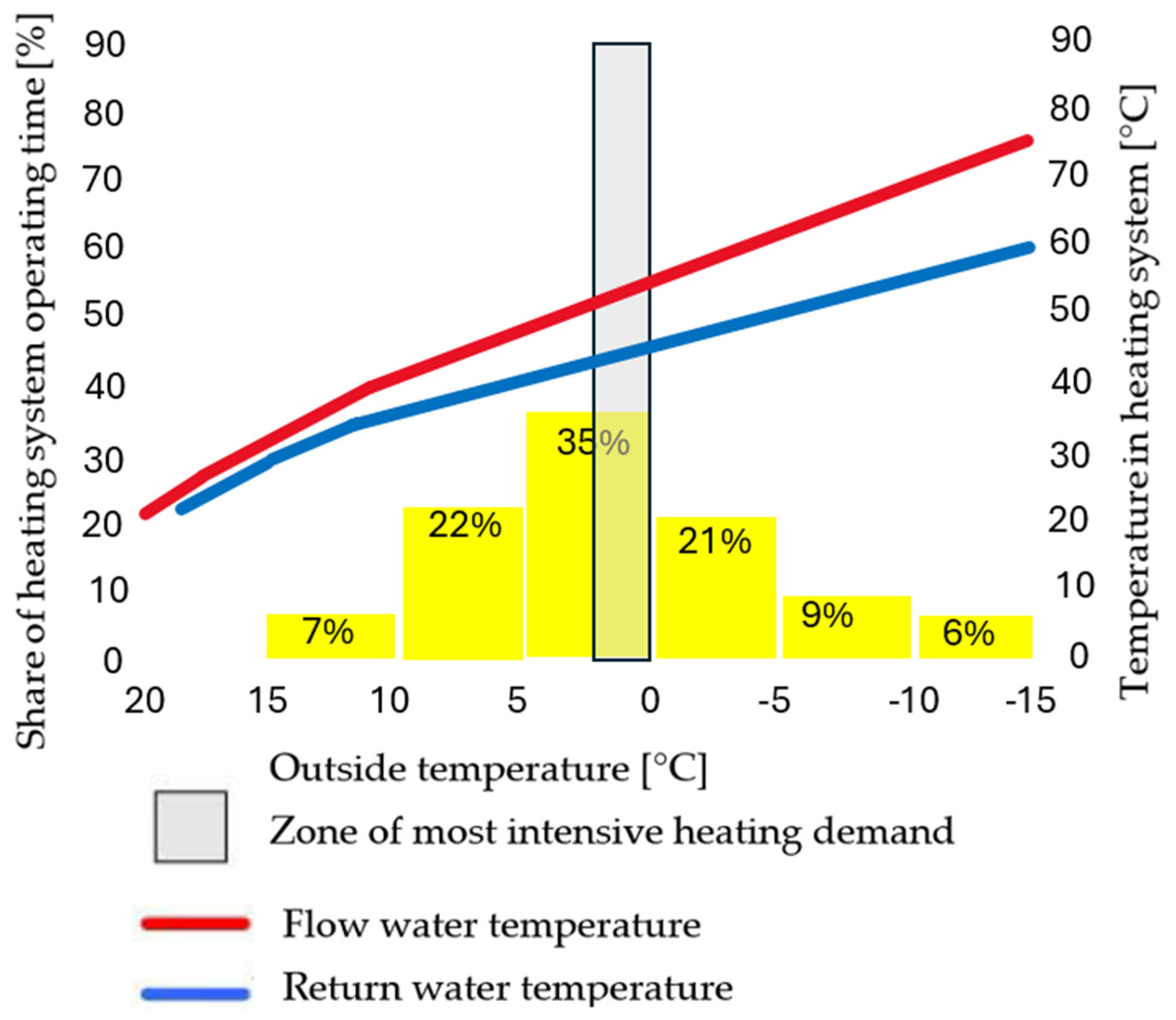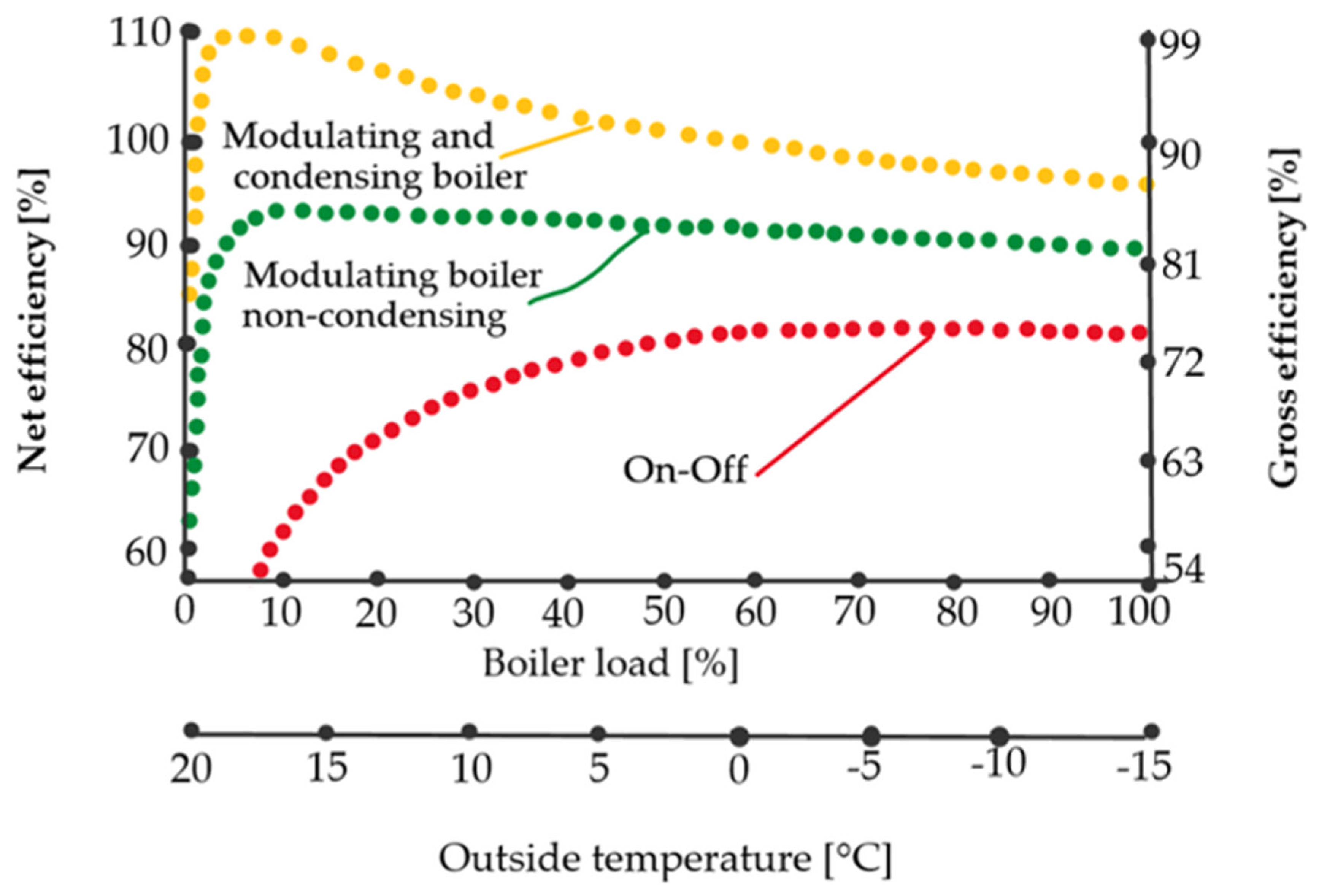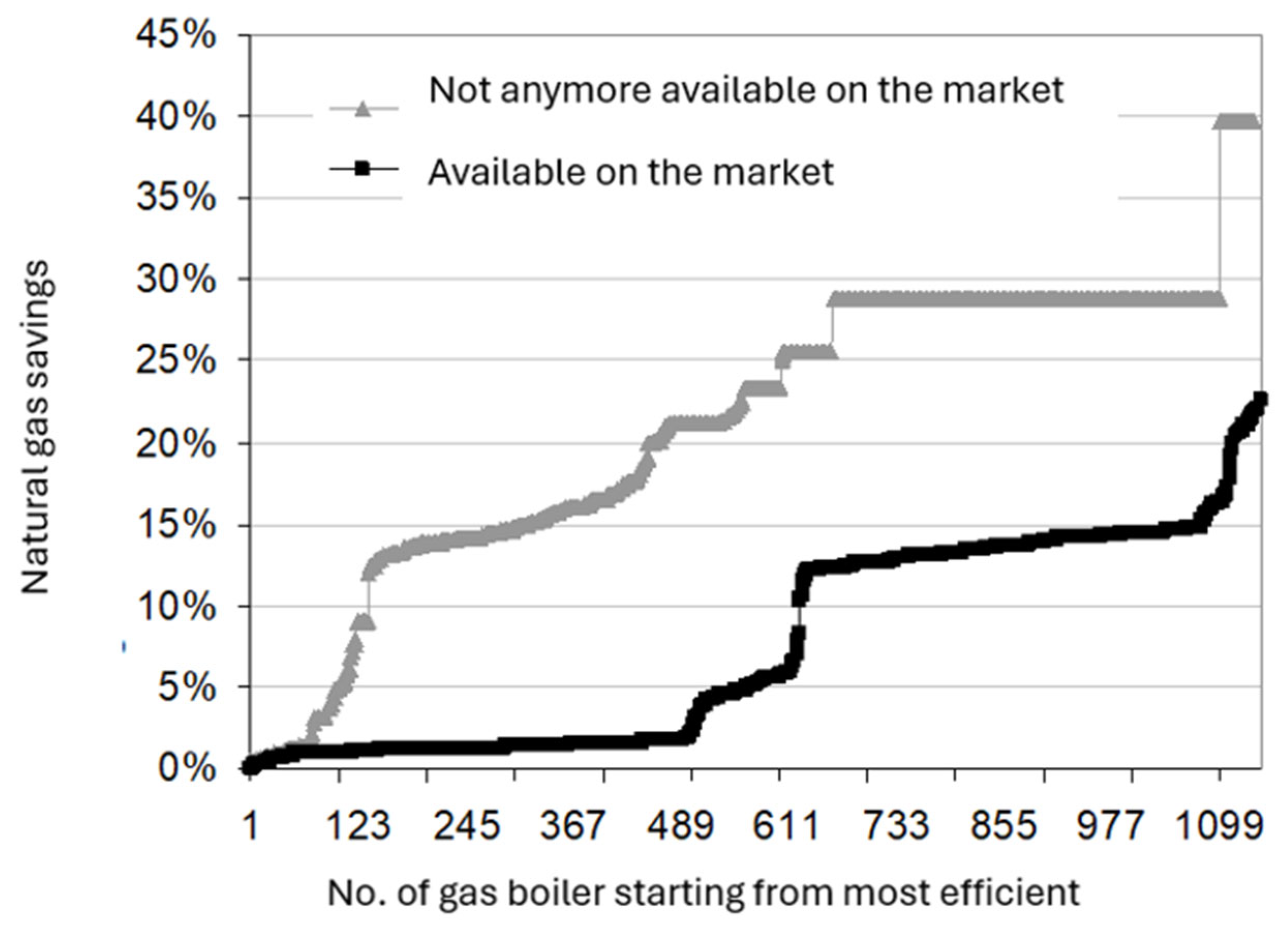European Efficiency Schemes for Domestic Gas Boilers: Estimation of Savings in Heating of Settlements
Abstract
1. Introduction
2. Gas Boilers
2.1. Legislation
- EU/2023/1791—Energy Efficiency Directive: This Directive aims to enhance energy efficiency by setting binding targets for reducing energy consumption and promoting energy-efficient practices [19];
- EU/2024/1275—Energy Performance of Buildings Directive: This Directive focuses on improving the energy performance of buildings, aiming for a fully decarbonized building stock by 2050. It includes measures for renovation, better air quality, and digitalization of energy systems for buildings [20];
- Directive 92/42/EEC: It sets efficiency requirements for new hot-water boilers fired with liquid or gaseous fuels, promoting energy efficiency and reducing energy consumption in the domestic and tertiary sectors. The Directive covers boilers operating on liquid and/or gaseous fuels with a nominal power of 4 kW to 400 kW.
- Directive 2004/8/EC (2004): Focused on the promotion of cogeneration based on a useful heat demand;
- Directive 2005/32/EC (2005): Established a framework for setting eco-design requirements for energy-using products;
- Directive 2008/28/EC (2008): Made further amendments to improve energy efficiency.
2.2. Calculation of Seasonal Efficiency
- The degrees of utilization at full load (Efull) and partial load (Epart), which serve as input data and cannot exceed the specified values, should be converted to the higher heating value (HHV) by multiplying them by a coefficient of 0.901 for gas boilers and 0.921 for liquid petroleum gas (LPG) boilers (SAP [22], Table D2.2);
- In the further course of calculation, it is necessary to determine the type of boiler in accordance with Section D1 and Table D2.3 in SAP [22]. Based on this, select the appropriate expression for the calculation of seasonal efficiency from Table D2.4. For example, for an on–off gas boiler (on–off regular), whether condensing or not, the Expression 101 applies (Equation (1)). For the same type with a storage reservoir (on–off storage combination), the Expression 105 applies (Equation (2)), according to SAP [22]. For modulating boilers, whether condensing or not, if they do not have a storage reservoir (modulating regular), the Expression 102 applies (Equation (3)). If they have a storage reservoir (modulating storage combination), the Expression 106 applies (Equation (4)), according to SAP [22], etc. Boilers covered by Expressions 101 and 102 provide heating but not domestic hot water in general (regular boilers). Boilers covered by Expressions 105 and 106 are combination boilers, which provide heating as well as domestic hot water and have an internal reservoir of at least 15 dm3 and at most 70 dm3. If the reservoir is larger than 70 dm3, the heating circuit must not be supplied from this reservoir. If it is supplied, then it does not fall under this class of boilers, and the seasonal efficiency is calculated by a different expression. If there is no expression number in Table D2.3 in SAP [22] that is selected from Table D2.4 in SAP [22] or if the designation X is present, the calculation cannot continue. For gas boilers and liquid petroleum gas (LPG) boilers, the parameter p in expressions 105, 102, and 106 is zero if they do not have a pilot flame. If they have a permanent pilot flame, then p = 1. The parameter b = 0 if the losses from the reservoir are not included for boilers with a reservoir or if the reservoir was not connected during testing; otherwise, b = 1. If there is a reservoir with a volume Vcs, in dm3, then the parameter L is calculated as L = 0.0945 + 0.0055t if t < 10 mm or as L = 0.394/t if t ≥ 10 mm, where t is the thickness of the insulation in millimeters.
- 3.
- The obtained result, i.e., seasonal efficiency (E), should be rounded to one decimal place (seasonal efficiency = [x]%), with mandatory reference to the Notified Body accredited for the testing of boilers by an EU National Accreditation Service, which confirms the input data and calculation method [13].
2.3. Energy Classes
3. Savings and Comparisons
3.1. Estimates of Annual Gas Savings
- Calculate the effective heating output of the current boiler: Multiply the annual fuel consumption by the efficiency of the current boiler (55%, i.e., 0.55): 1260 m3 × 0.55 = 693 m3;
- Determine the required fuel consumption for the new boiler: Divide the effective heating output by the efficiency of the new boiler (95% i.e., 0.95): 693 m3/0.95 ≈ 729.47 m3.
3.2. Comparison of Boilers
4. Conclusions
Funding
Data Availability Statement
Conflicts of Interest
Appendix A. Condensation Technology

- Lower heating value (LHV) is the energy released during complete combustion, with the water produced in the process, being separated as vapor;
- Higher heating value (HHV) determines the energy released during the complete process, including the heat of vaporization contained in the water vapor of hot gases.
| in kWh/m3 | Lower Heating Value (LHV) | Higher Heating Value (HHV) |
|---|---|---|
| Natural gas | ~10 | ~11 |
| Propane | 25.8 | 28.1 |
| City gas 1 | ~4.2 | ~5.0 |
| Heating oil 2 | ~10 | ~10.6 |
Appendix A.1. Efficiency of a Condensing Boiler
- Sensible heat refers to the heat that causes a change in the temperature of a substance without changing its state. In condensing boilers, sensible heat is the energy used to raise the temperature of the water or air being heated;
- Latent heat is the heat absorbed or released during a phase change, such as when water vapor condenses into liquid water. Condensing boilers capture this latent heat from the water vapor in the flue gases, which significantly improves their efficiency.
Appendix A.2. Average Normative Efficiency of a Condensing Boiler

Appendix A.3. Nominal Thermal Load

References
- Tsoumalis, G.I.; Bampos, Z.N.; Chatzis, G.V.; Biskas, P.N. Overview of Natural Gas Boiler Optimization Technologies and Potential Applications on Gas Load Balancing Services. Energies 2022, 15, 8461. [Google Scholar] [CrossRef]
- Brkić, D.; Tanasković, T.I. Systematic Approach to Natural Gas Usage for Domestic Heating in Urban Areas. Energy 2008, 33, 1738–1753. [Google Scholar] [CrossRef]
- Roca Reina, J.C.; Carlsson, J.; Volt, J.; Toleikyte, A. Alternatives for Decarbonising High-Temperature Heating Facilities in Residential Buildings. Energies 2025, 18, 235. [Google Scholar] [CrossRef]
- Horák, J.; Kuboňová, L.; Dej, M.; Ryšavý, J.; Bajer, S.; Kysučan, Z.; Ulrich, P.; Mareček, P.; Tesař, F.; Garba, M.; et al. Long-Term Neutralization of Acidic Condensate from Gas Condensing Boilers. Sustainability 2022, 14, 15015. [Google Scholar] [CrossRef]
- Fernández-Cheliz, D.; Velasco-Gómez, E.; Peral-Andrés, J.; Tejero-González, A. Energy Performance Optimization in a Condensing Boiler. Environ. Sci. Proc. 2021, 9, 6. [Google Scholar] [CrossRef]
- Spiridon, Ş.I.; Monea, B.F.; Ionete, E.I. Optimizing a Hydrogen and Methane Blending System Through Design and Simulation. Fuels 2025, 6, 28. [Google Scholar] [CrossRef]
- Siksnelyte-Butkiene, I.; Karpavicius, T.; Streimikiene, D.; Balezentis, T. The achievements of climate change and energy policy in the European Union. Energies 2022, 15, 5128. [Google Scholar] [CrossRef]
- Cifuentes-Faura, J. European Union policies and their role in combating climate change over the years. Air Qual. Atmos. Health 2022, 15, 1333–1340. [Google Scholar] [CrossRef]
- Rafique, A.; Williams, A.P. Reducing household greenhouse gas emissions from space and water heating through low-carbon technology: Identifying cost-effective approaches. Energy Build. 2021, 248, 111162. [Google Scholar] [CrossRef]
- Cherry, C.; Hopfe, C.; MacGillivray, B.; Pidgeon, N. Homes as machines: Exploring expert and public imaginaries of low carbon housing futures in the United Kingdom. Energy Res. Soc. Sci. 2017, 23, 36–45. [Google Scholar] [CrossRef]
- Brkić, D. Serbian energy sector in the global political landscape amid the Russia-Ukraine war: A focus on perspectives of integration into the European Union. Discov. Energy 2024, 4, 29. [Google Scholar] [CrossRef]
- Brkić, D. Serbian energy sector in a gap between east and west. Energy Explor. Exploit. 2024, 42, 330–340. [Google Scholar] [CrossRef]
- Brkić, D.; Praks, P. Proper Use of Technical Standards in Offshore Petroleum Industry. J. Mar. Sci. Eng. 2020, 8, 555. [Google Scholar] [CrossRef]
- Cellura, M.; La Rocca, V.; Longo, S.; Mistretta, M. Energy and environmental impacts of energy related products (ErP): A case study of biomass-fueled systems. J. Clean. Prod. 2014, 85, 359–370. [Google Scholar] [CrossRef]
- Hanby, V.I. Modelling the Performance of Condensing Boilers. J. Energy Inst. 2007, 80, 229–231. [Google Scholar] [CrossRef]
- Brkić, D. Fire Hazards Caused by Equipment Used in Offshore Oil and Gas Operations: Prescriptive vs. Goal-Oriented Legislation. Fire 2025, 8, 29. [Google Scholar] [CrossRef]
- Zangheri, P.; Economidou, M.; Labanca, N. Progress in the Implementation of the EU Energy Efficiency Directive through the Lens of the National Annual Reports. Energies 2019, 12, 1107. [Google Scholar] [CrossRef]
- Zangheri, P.; D’Agostino, D.; Armani, R.; Bertoldi, P. Review of the Cost-Optimal Methodology Implementation in Member States in Compliance with the Energy Performance of Buildings Directive. Buildings 2022, 12, 1482. [Google Scholar] [CrossRef]
- Bačovský, M.; Karásek, J.; Kaločai, L. Development of Municipal Energy Management as Trigger of Future Energy Savings. Buildings 2024, 14, 899. [Google Scholar] [CrossRef]
- Maduta, C.; D’Agostino, D.; Tsemekidi-Tzeiranaki, S.; Castellazzi, L.; Melica, G.; Bertoldi, P. Towards Climate Neutrality within the European Union: Assessment of the Energy Performance of Buildings Directive Implementation in Member States. Energy Build. 2023, 301, 113716. [Google Scholar] [CrossRef]
- Dill, A.; Brown, T.R.; Malmsheimer, R.W.; Ha, H.; Frank, J.; Kileti, P.; Barkwill, B. Quantifying the Financial and Climate Impacts of Greenhouse Gas Abatement Pathways in Residential Space Heating. Sustainability 2024, 16, 2135. [Google Scholar] [CrossRef]
- Building Energy Performance Assessment. Available online: https://www.ncm-pcdb.org.uk/sap/ (accessed on 27 April 2025).
- Seraj, H.; Bahadori-Jahromi, A.; Amirkhani, S. Developing a Data-Driven AI Model to Enhance Energy Efficiency in UK Residential Buildings. Sustainability 2024, 16, 3151. [Google Scholar] [CrossRef]
- Johnston, D.; Glew, D.; Miles-Shenton, D.; Benjaber, M.; Fitton, R. Quantifying the performance of a passive deaerator in a gas-fired closed loop domestic wet central heating system. Build. Serv. Eng. Res. Technol. 2016, 38, 269–286. [Google Scholar] [CrossRef]
- Bennett, G.; Elwell, C.; Lowe, R.; Oreszczyn, T. The Importance of Heating System Transient Response in Domestic Energy Labelling. Buildings 2016, 6, 29. [Google Scholar] [CrossRef]
- New EU Energy Labels Applicable from 1 March 2021. Available online: https://ec.europa.eu/commission/presscorner/detail/en/ip_21_818 (accessed on 27 April 2025).
- Menegon, D.; Lobosco, D.; Micò, L.; Fernandes, J. Labeling of Installed Heating Appliances in Residential Buildings: An Energy Labeling Methodology for Improving Consumers’ Awareness. Energies 2021, 14, 7044. [Google Scholar] [CrossRef]
- de Ayala, A.; Solà, M.d.M. Assessing the EU Energy Efficiency Label for Appliances: Issues, Potential Improvements and Challenges. Energies 2022, 15, 4272. [Google Scholar] [CrossRef]
- Durmus Senyapar, H.N.; Duzgun, B.; Boran, F.E. Energy Labels and Consumer Attitudes: A Study among University Staff. Sustainability 2024, 16, 1754. [Google Scholar] [CrossRef]
- Stasiuk, K.; Maison, D. The Influence of New and Old Energy Labels on Consumer Judgements and Decisions about Household Appliances. Energies 2022, 15, 1260. [Google Scholar] [CrossRef]
- Bennett, G.; Elwell, C. Effect of boiler oversizing on efficiency: A dynamic simulation study. Build. Serv. Eng. Res. Technol. 2020, 41, 709–726. [Google Scholar] [CrossRef]
- Park, C.; Kim, L. A development of test method on the energy consumption efficiency of domestic gas boiler below 70 kW. J. Energy Eng. 2016, 25, 73–82. [Google Scholar] [CrossRef]
- Energy Saving Trust: How We Calculate Our Energy Saving Data. Available online: https://energysavingtrust.org.uk/about-us/our-data/ (accessed on 27 April 2025).
- Mukisa, P.J.; Ketuama, C.T.; Roubík, H. Biogas in Uganda and the Sustainable Development Goals: A Comparative Cross-Sectional Fuel Analysis of Biogas and Firewood. Agriculture 2022, 12, 1482. [Google Scholar] [CrossRef]
- Praks, P.; Lampart, M.; Praksová, R.; Brkić, D.; Kozubek, T.; Najser, J. Selection of Appropriate Symbolic Regression Models Using Statistical and Dynamic System Criteria: Example of Waste Gasification. Axioms 2022, 11, 463. [Google Scholar] [CrossRef]
- Kociuba, D.; Janczak, M. Effects of the Disbursement of EU Cohesion Policy 2014–2020 Funds on Improving the Energy Efficiency of Buildings in Poland and Germany. Energies 2024, 17, 4417. [Google Scholar] [CrossRef]
- de Montlivault, P. Décarbonation de la chaleur: Faire feu de tout bois. Rev. De L’energie 2024, 672, 11–13. [Google Scholar] [CrossRef]
- Tomo, A. “Ecobonus” and “ecotax”: Two recent Italian fiscal measures to promote the decarbonisation in the vehicles system. In Economic Instruments for a Low-Carbon Future; Edward Elgar Publishing: Cheltenham, UK, 2020; pp. 70–80. [Google Scholar] [CrossRef]
- Hiris, D.; Balan, M.C.; Bode, F.I. A Comprehensive Review on Enhancing Seasonal Energy Storage Systems through Energy Efficiency Perspectives. Processes 2024, 12, 1623. [Google Scholar] [CrossRef]
- Vespasiano, D.; Sgaramella, A.; Lo Basso, G.; de Santoli, L.; Pastore, L.M. Hydrogen Blending in Natural Gas Grid: Energy, Environmental, and Economic Implications in the Residential Sector. Buildings 2024, 14, 2284. [Google Scholar] [CrossRef]
- Bliek, F.W.; van den Noort, A.; Roossien, B.; Kamphuis, R.; de Wit, J.; van der Velde, J.; Eijgelaar, M. The role of natural gas in smart grids. J. Nat. Gas Sci. Eng. 2011, 3, 608–616. [Google Scholar] [CrossRef]
- Vivanco-Martín, B.; Iranzo, A. Analysis of the European Strategy for Hydrogen: A Comprehensive Review. Energies 2023, 16, 3866. [Google Scholar] [CrossRef]
- Bayssi, O.; Nabil, N.; Azaroual, M.; Bousselamti, L.; Boutammachte, N.; Rachidi, S.; Barberis, S. Green hydrogen landscape in North African countries: Strengths, challenges, and future prospects. Int. J. Hydrogen Energy 2024, 84, 822–839. [Google Scholar] [CrossRef]
- Penttinen, S.L. Navigating the hydrogen landscape: An analysis of hydrogen support mechanisms in the US and the EU. Rev. Eur. Comp. Int. Environ. Law 2024, 33, 397–411. [Google Scholar] [CrossRef]
- Vignali, G. Environmental assessment of domestic boilers: A comparison of condensing and traditional technology using life cycle assessment methodology. J. Clean. Prod. 2017, 142, 2493–2508. [Google Scholar] [CrossRef]
- Baldi, S.; Le Quang, T.; Holub, O.; Endel, P. Real-time monitoring energy efficiency and performance degradation of condensing boilers. Energy Convers. Manag. 2017, 136, 329–339. [Google Scholar] [CrossRef]
- Zhang, S.; Shen, M.; Kang, Y.; Tang, Z. The Design and Experimental Study of a Deep-Condensing Waste Heat Recovery System for Boiler Flue Gas Based on Baoneng Heating Plant. Processes 2025, 13, 306. [Google Scholar] [CrossRef]
- Song, M.J.; Kim, W.C.; Lee, S.Y. The Corrosion Failure Mechanism of a Peak Load Boiler in a District Heating System. Appl. Sci. 2025, 15, 4528. [Google Scholar] [CrossRef]









| Type of Boilers | At the Nominal Power of the Boiler (%) | At Partial Load of the Boiler (%) |
|---|---|---|
| Standard | ≥84 + 2logPn | ≥80 + 3logPn |
| Low-temperature | ≥87.5 + 1.5logPn | ≥87.5 + 1.5logPn |
| Condensing 2 | ≥91 + logPn | ≥97 + logPn |
| Pn—Power given in kW and can range from 4 to 400 kW | ||
| SEDBUK (Seasonal Efficiency of Domestic Boilers in the UK) Efficiency Classes | Energy-Related Products (ErP) Efficiency Classes |
|---|---|
| -Provides a detailed percentage rating indicating the exact proportion of fuel converted into usable heat over a typical year | -Uses a simpler A+++ to G rating system to classify boiler efficiency |
| -Primarily used in the UK for new-build homes | -Applies across Europe to all residential and commercial heating products |
| -Was the standard from 1999 to 2015, still referenced for new buildings | -Introduced in 2015, replacing SEDBUK for existing properties |
| -Offers precise efficiency percentages, allowing detailed comparison | -Provides a more straightforward, consumer-friendly label system |
| -Focuses on detailed efficiency metrics | -Includes regulations for manufacturers to meet higher energy efficiency standards before products can be sold |
| SEDBUK (Seasonal Efficiency of Domestic Boilers in the UK) Efficiency Classes 2 | Energy-related Products (ErP) Efficiency Classes 3 |
|---|---|
| A: 90% and above B: 86% to 90% C: 82% to 86% D: 78% to 82% E: 74% to 78% F: 70% to 74% G: Below 70% | A+++: 98% and above A++: 95% to 98% A+: 92% to 95% A: 90% to 92% B: 82% to 90% C: 77% to 82% D: 70% to 77% E: 65% to 70% F: 60% to 65% G: Below 60% |
Disclaimer/Publisher’s Note: The statements, opinions and data contained in all publications are solely those of the individual author(s) and contributor(s) and not of MDPI and/or the editor(s). MDPI and/or the editor(s) disclaim responsibility for any injury to people or property resulting from any ideas, methods, instructions or products referred to in the content. |
© 2025 by the author. Licensee MDPI, Basel, Switzerland. This article is an open access article distributed under the terms and conditions of the Creative Commons Attribution (CC BY) license (https://creativecommons.org/licenses/by/4.0/).
Share and Cite
Brkić, D. European Efficiency Schemes for Domestic Gas Boilers: Estimation of Savings in Heating of Settlements. Algorithms 2025, 18, 416. https://doi.org/10.3390/a18070416
Brkić D. European Efficiency Schemes for Domestic Gas Boilers: Estimation of Savings in Heating of Settlements. Algorithms. 2025; 18(7):416. https://doi.org/10.3390/a18070416
Chicago/Turabian StyleBrkić, Dejan. 2025. "European Efficiency Schemes for Domestic Gas Boilers: Estimation of Savings in Heating of Settlements" Algorithms 18, no. 7: 416. https://doi.org/10.3390/a18070416
APA StyleBrkić, D. (2025). European Efficiency Schemes for Domestic Gas Boilers: Estimation of Savings in Heating of Settlements. Algorithms, 18(7), 416. https://doi.org/10.3390/a18070416








